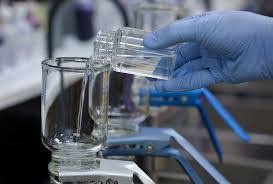Microbiological examination of water is necessary in order to maximize the use of water without falling into trouble caused by micro-organisms in the same. It is pertinent that microscopic examination be done before water is used for any purpose.
Heterotrophic plate count (HPC) of more than 500 / ml in tap water indicates variation in water quality and potential for pathogen survival.
They also mask the coliforms and fecal coliforms when present in high numbers. Bottled water and charcoal filters of household taps have high HPC.
Gram negative bacteria belonging to bacterium Pseudomonas, Aeromonas, Klebsiella, Flavo, Enterobacter, Citrobacter, Serratia, Proteus, and Moroxella, etc., are detected in HPC.
Monitoring and detection of indictor and disease causing micro-organisms is a major part of sanitary microbiology. Intestinal tract bacteria do not survive in the aquatic environment and are under physiological stress and loose their ability to grow on selective media.
Although many pathogens can be detected directly in water, environmental microbiologists have generally used indicator or index organisms as an indirect evidence of possible water contamination by human pathogens which are considered to be of fecal origin. The criteria for an ideal indicator organism are:
- It should be useful for all types of water.
- It should be present whenever enteric pathogens are present.
- The organism should have reasonably longer survival time than the hardiest of pathogens.
- The organism should not grow in water.
- The testing method should be easy to perform.
- The density of indictor organisms should have direct relationship to the degree of fecal pollution.
- The organism should always be found in intestinal microflora of warm blooded animals.
Conventionally, coliforms have been used as indicator organisms of fecal pollution. Various indicator organisms are now considered for their different attributes and usefulness as no organism satisfies all the above criteria.
Read Also: Importance of Water Microbiology
Among the various indicators are coliforms, fecal streptococci, Clostridium perfringens, Bifidobacterium and Bacteroides, phages of enteric bacteria, Pseudomonas aeruginosa, Staphylococcus aureus, Candida albicans and Aeromonas hydrophila.
Coliforms are defined as facultatively anaerobic Gram negative, non-spore forming, short rod- shaped bacteria that produce acid and gas on lactose fermentation in prescribed culture medium within 48h at 35º C.

The group includes Escherichia, Citrobacter, Enterobacter and Klebsiella. Escherichia coli and Klebsiella pneumoniae are the important coliforms. E.coli is a natural inhabitant of the intestine and K. pneumoniae is that of soil. The test for coliforms involves presumptive, confirmed and completed tests.
The presumptive test is clubbed with the multiple tube dilution technique which gives an estimate of most probable number (MPN) of coliforms in 100 ml of water sample and is also called MPN test.
In MPN test different sample volumes are inoculated in lactose broth or McConkey broth at 35ºC for 48h incubation. The test is based on the principle that a single living cell can develop into a turbid culture.
By determining the average dilution at which the tubes do not receive cells, the number of micro-organisms most probably present in the original sample can be computed using the MPN table.
In the confirmed test typical greenish metallic sheen colonies on EMB indicate fecal coliforms whereas non-fecal coliforms give mucoid pink colonies with dark centers called atypical colonies.
The completed test involves confirmation of coliforms. Gram negative non-spore forming, lactose fermenting (within 48h, rod shaped bacteria indicate fecal coliforms.
Read Also: Characteristics and Flow Rates of Waste-Water
Membrane filter technique (MF) is another useful test that consists of passing the water through a membrane filter. The filter with bacteria is transferred to the surface of a solid medium or to an absorptive pad containing the desired liquid medium.
Use of appropriate media helps in the detection of total, fecal and non-fecal coliforms. A resuscitation medium may be used to revive injured or stressed coliforms due to chlorination etc.
The MF technique gives good reproducibility and the results are obtained in one step, filters can be transferred between different media, large volumes of sample can be processed, is time saving, can be performed on site and bears low cost.
While the test is not suitable for high turbidity samples, other bacteria or metals and chemicals adsorb on the filter and may inhibit the growth of coliforms.
Table: Other Indicator Organisms
| S/N | Indicatororganism | Characteristics | Significance |
| 1. | Clostridium perfringens | Anaerobic spore former, gram positive rod shaped and exclusively of fecal origin. Spores are resistant and persist for long periods. | Useful indicator of past pollution, a tracer for less hardy indicators, protozoans and viruses. |
| 2. | Bifidobacterium and Bacteroids | Primarily associated with humans they can distinguish human and animal contamination. | B. bifidus survives for a short time therefore its presence suggests relatively recent pollution |
| 3. | F-specific RNA phage, f2, φx174, MS2, PRD-1 | Coliphages, not always seen associated with fecal pollution however their presence in high numbers in waste-water and high resistance to chlorination can be an index of waste-water contamination and indicators of enteric viruses. | useful for evaluation of virus resistance to disinfectants, fate of enteric viruses in water treatment and surface or groundwater tracers and presence of host. |
| 4. | Phages of Bacteroides fragilis | of human origin exclusively | An advantage over coliphage is they help to detect human fecal contamination. They do not multiply in the water and have decay rate similar to other viruses. |
| 5. | Pseudomonas aeruginosa | Associated with the diseases of eye, ear, nose and throat infections. common opportunistic pathogen, causes life threatening infection in burn patients and Immune-compromised individuals. Folliculitis, dermatitis, ear and urinary infections are common in ill maintained swimming pools. | This organism is of no value as indicator of fecal pollution however coliforms do not suit as indictor of contamination of swimming pool water as the contamination is not of fecal origin. |
| 6. | Staphylococcus aureus and Candida albicans | suggests the sanitary quality of water because it presence is associated with human activities | Useful for recreational waters. |
Read Also: Abyssinian Cat (Felis catus) Description and Complete Care Guide

